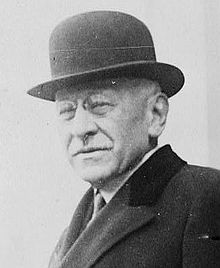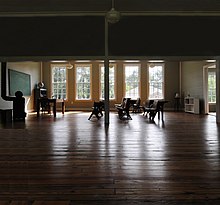Rosenwald School
In informal usage, a Rosenwald School was any of the over five thousand schools, shops, and teachers' homes in the United States which were built primarily for the education of African-American children in the South in the early 20th century. The project was the product of the partnership of Julius Rosenwald, a Jewish American clothier who became part-owner and president of Sears, Roebuck and Company and the African American leader, educator, philanthropist and president of Tuskegee Institute, Booker T. Washington.[1]
The need arose from the chronic underfunding of public education for African-American children in the South, as black people had been disenfranchised at the turn of the century and excluded from the political system in that region. Children were required to attend racially segregated schools.
Rosenwald was the founder of The Rosenwald Fund. He contributed seed money for many of the schools and other philanthropic causes, requiring local communities to raise matching funds to increase their commitment to these projects.
To promote collaboration between white and black citizens, Rosenwald required communities to commit public funds and/or labor to the schools, as well as to contribute additional cash donations. White school boards had to agree to operate and maintain the schools, and millions of dollars were raised by African-American rural communities across the South to fund better education for their children. Despite this program, by the mid-1930s, white schools in the South were worth, per student, more than five times what black schools were worth per student (in majority-black Mississippi, this ratio was more than 13 to one).[2]
Significance of the Rosenwald-Washington Collaboration
In the segregated schools of the South, African American children were sent to woefully underfunded schools. The collaboration of Rosenwald and Washington led to the construction of almost 5,000 schools for black children in the eleven states of the former Confederacy as well as Oklahoma, Missouri, Kentucky, and Maryland. As a result of their collaboration approximately one-third of African American children were educated in these schools.[3]
The Rosenwald-Washington model required the buy-in of African American communities as well as the support of white governing bodies. Black communities raised more than $4.7 million to aid in construction [1], plus often donating land and labor. Research has found that the Rosenwald program accounts for a sizable portion of the educational gains of rural Southern black persons in this period. This research also found significant effects on school attendance, literacy, years of schooling, cognitive test scores, and Northern migration, with gains highest in the most disadvantaged counties.[4]
Role of Julius Rosenwald

Julius Rosenwald (1862–1932) was born to a German-Jewish immigrant family. He became a clothier by trade after learning the business from relatives in New York City. His first business went bankrupt; however, another he began in Chicago, Illinois became a leading supplier to Richard Sears' business. Sears, Roebuck and Company was a growing mail-order business which served many rural Americans. Anticipating demand by using the variations of sizes in American men and their clothing determined during the American Civil War, Rosenwald helped plan the growth in what many years later marketers would call "the softer side of Sears": clothing. In 1895, he became one of its investors, eventually serving as the president of Sears from 1908 to 1922. He was its chairman until his death in 1932.
After the 1906 reorganization of the Sears company as a public stock corporation by the financial services firm of Goldman Sachs, one of the senior partners, Paul Sachs, often stayed with the Rosenwald family at their home during his many trips to Chicago. Julius Rosenwald and Sachs would often discuss America's social situation, agreeing that the plight of African Americans was the most serious problem in the United States. The millions in the South had been disenfranchised at the turn of the century and suffered second-class status in a system of Jim Crow segregation. Black public schools and other facilities were chronically underfunded.
Role of Booker T. Washington

Sachs introduced Rosenwald to Booker T. Washington, (1856 - 1915) the famed educator who in 1881 started as the first principal of the normal school which he developed as Tuskegee University in Alabama. Washington, who had gained the respect of many American leaders including U.S. President Theodore Roosevelt, had also obtained financial support from wealthy philanthropists such as Andrew Carnegie, George Eastman and Henry Huttleston Rogers. He encouraged Rosenwald, as he had others, to address the poor state of African-American education in the U.S.
In 1912, Rosenwald was asked to serve on the Board of Directors of Tuskegee, a position he held until his death in 1932. Rosenwald endowed Tuskegee so that Washington could spend less time traveling to seek funding and devote more time toward management of the school. As urged by Washington, Rosenwald provided funds for the construction of six small schools in rural Alabama, which were constructed and opened in 1913 and 1914 and overseen by Tuskegee.
Rosenwald Fund

Julius Rosenwald and his family established The Rosenwald Fund in 1917 for "the well-being of mankind." Unlike other endowed foundations, which were designed to fund themselves in perpetuity, The Rosenwald Fund was intended to use all of its funds for philanthropic purposes. It donated over 70 million dollars to public schools, colleges and universities, museums, Jewish charities and black institutions before funds were completely depleted in 1948.
The school building program was one of the largest programs administered by the Rosenwald Fund. Using state-of-the-art architectural plans designed by professors at Tuskegee Institute,[5] the Fund spent more than four million dollars to build 4,977 schools, 217 teachers' homes, and 163 shop buildings in 883 counties in 15 states, from Maryland to Texas. The Rosenwald Fund was based on a system of matching grants, requiring white school boards to commit to maintenance and black communities to aid in construction.
Preservation

In some communities, surviving structures have been preserved because of the deep meaning they had for African Americans as symbols of their leaders' and communities' dedication to education. Others were threatened by lack of funds in rural areas, urbanization and changes in demographics, changing style of education to consolidated and integrated schools, and other social changes.
Former Rosenwald students have led some efforts to preserve Rosenwald Schools. For example, in Georgia, three former Rosenwald Schools were preserved by the efforts of former students and Georgia's Historic Preservation Division, leading to their being listed on the National Register of Historic Places by 2001.[6]
In 2002, the National Trust for Historic Preservation named Rosenwald Schools near the top of the country's most endangered places [2] and created a campaign to raise awareness and money for preservation. At least 60 former Rosenwald Schools are listed on the National Register of Historic Places.[7] In 2015 the National Trust classified the Rosenwald Schools as National Treasures.

In Georgia, several Rosenwald School sites have been commemorated through the Georgia Historical Marker Program, currently administered by the Georgia Historical Society. In partnership with community organizations, markers have been erected for the Hiram Rosenwald School (2006, Paulding County), Macon County Training School (2016, Macon County), Barney Colored Elementary School (2013, Brooks County), and Noble Hill Rosenwald School (1995 by the Georgia Department of Natural Resources, Bartow County).
Some schools have been adapted for new uses. Walnut Cove Colored School in Stokes County, North Carolina won a National Preservation Honor Award for its rehabilitation for use as a senior citizens' community center. The Hope Rosenwald School in Pomaria, South Carolina will also be used as a community center. The Highland Park School in Prince George's County, Maryland had been in continuous use by the school system. It was recently renovated for use as a Headstart Center. The Canetuck Rosenwald School in Currie, North Carolina has been renovated by the local Black community and is used as a busy community center. The Beauregard Parish Training School in DeRidder, Louisiana was renovated with a federal grant in 2007 and open in 2009 as BeauCare Head Start.[8]
See also
- List of Rosenwald schools
- Jane Addams
- Grace Abbott
- Emil Hirsch
- Julian Mack
- Claudia Stack
- Rosenwald (film)
- Rosenwald Junior College
- Ragged schools, in Britain
References
- ^ Deutsch, Stephanie (2015). You Need a Schoolhouse: Booker T. Washington, Julius Rosenwald, and the Building of Schools for the Segregated South. Evanston, Illinois: Northwestern University Press. ISBN 0-8101-3127-7.
- ^ McMillen, Neil R. (1990). Dark Journey: Black Mississippians in the Age of Jim Crow. University of Illinois Press. p. 84. ISBN 0-252-06156-X.
- ^ Brooker, Russell; Kaplan, Fran. "The Rosenwald Schools: An Impressive Legacy of Black-Jewish Collaboration for Negro Education". America's Black Holocaust Museum. Archived from the original on 2013-06-15.
{{cite web}}: Unknown parameter|deadurl=ignored (|url-status=suggested) (help) - ^ Federal Reserve Bank of Chicago, "The Impact of Rosenwald Schools on Black Achievement", September 2011
- ^ "History of the Rosenwald School Program". National Trust for Historic Preservation. Retrieved December 14, 2013.
- ^ "Saving Georgia's Rosenwald Schools" (PDF). Reflections. 1 (4). Historic Preservation Division, Georgia Department of Natural Resources: 3–5. August 2001.
- ^ At least 60 in List of Rosenwald Schools are documented to be NRHP-listed.
- ^ KPLCTV: Historic DeRidder school starts new chapter- Retrieved 2016-07-27
External links
- Rosenwald Schools of South Carolina, An Oral History Exhibit, University of South Carolina
- Saving the Rosenwald Schools: Preserving African American History
- Rosenwald Schools Initiative, National Trust for Historic Preservation
- Rosenwald School Archives at Fisk University, searchable database of many Rosenwald Schools, with historic data and photos from when they were built
- "Rosenwald Schools", History South:
- Rosenwald Harlanites, Inc., non-profit organization to preserve the legacy of the Rosenwald School in Harlan, Kentucky
- Shiloh Community Restoration Project, a non-profit organization to restore the Shiloh-Rosenwald School, Notasulga, AL
- Noble Hill Wheeler Memorial Center; restored 1923 Rosenwald school in NW Georgia
- Photographs of some Rosenwald Schools by Sarah Hoskins
- Under the Kudzu, a film by Claudia Stack about two NC Rosenwald schools
- Carrie Mae: An American Life, a film by Claudia Stack about a teacher who was educated and taught in Rosenwald schools
